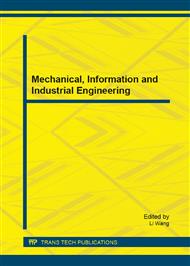p.146
p.150
p.154
p.161
p.165
p.171
p.175
p.180
p.186
Fast Communication and Efficient Architecture of Intelligent Vehicle
Abstract:
Intelligent Ground Vehicle needs real-time communication system and a better architecture to handle a variety of sensors. This paper presents a fast communication and efficient architecture for intelligent vehicle (FCEA-IV). The vehicle contains three control centers, communicating with each other based on real-time control system. And also it has a hybrid mode. In auto driving mode, it will go under the better path, calculated by considering comprehensive environmental factors. While in active control mode, the vehicle will be controlled by remote commands. First of all, we will discuss RCS (real-time control system) and why we choose it. Then the overview of system, including architecture and control structure will be discussed. Further some communication message and work flow will be studied in detail. At last we share some experiments to test the efficiency of the communication system.
Info:
Periodical:
Pages:
165-170
Citation:
Online since:
March 2015
Authors:
Price:
Сopyright:
© 2015 Trans Tech Publications Ltd. All Rights Reserved
Share:
Citation:


